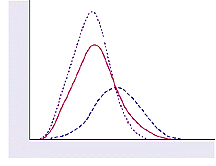Night VisionThe LRC is working on projects to develop and confirm performance criteria for light sources used for low-light, off-axis vision tasks such as night driving and security lighting. Project sponsors are currently providing funding for more basic research on the sensitivity of the eye under low light conditions.The LRC conducted an experiment measuring human reaction times to flashed targets seen either on-axis (looking directly at target) or off-axis (in the periphery of the view), under metal halide (MH) and high pressure sodium (HPS) sources at low light levels (0.003 to 10 cd/m 2). Reaction time depends on the amount of light present; increasing the light level shortens reaction times to visual stimuli.
Implications The differences in reaction times for stimuli of equal photopic luminance from spectrally different light sources show that the standard photopic response is not appropriate for comparing the efficacy of light sources used for low light-level applications where off-axis vision is important. A preliminary model for mesopic visual sensitivity and the results of this experiment enabled the LRC to calculate the comparative mesopic luminous efficacy of other light sources. More important, knowledge of the spectral sensitivity of the visual system can lead to the development of lamps for outdoor applications that are tuned to provide maximal visual benefit for minimal power consumption. (Refer to table.)
Sponsors: |
Advancing the effective use of light for society and the environment



 The efficacy of MH improves compared to HPS for off-axis detection. MH is slightly less efficacious than HPS at photopic light levels but more than twice as efficacious as HPS at low light levels. (
The efficacy of MH improves compared to HPS for off-axis detection. MH is slightly less efficacious than HPS at photopic light levels but more than twice as efficacious as HPS at low light levels. (